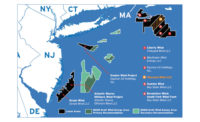The U.S. Dept. of Interior will decide later this year whether to approve construction of all or parts of ConocoPhillips' proposed Willow oil and gas drilling project on Alaska’s North Slope, or to reject it entirely, the agency said in a new draft environmental impact statement released July 8.
The project, now estimated at $8 billion and located in the National Petroleum Reserve on federal land, is seen as able to produce more than 180,000 barrels of oil per day. It was approved by the Trump Administration.
But a federal district judge in Alaska last August found deficiencies in the environmental review by the Interior Dept.'s Bureau of Land Management (BLM) and ordered it to consider additional climate change impacts from the project such as downstream foreign greenhouse gas emissions and possible damage to the Teshekpuk Lake Special Area, which includes Alaska's third largest lake and protected wildlife habitat.
Environmentalists call Willow a “carbon bomb” and argue that it is “clearly inconsistent” with the Biden administration’s goal to transition away from fossil fuels to avert the worst consequences of the climate crisis.
However, the Biden administration backed the project in the court case and did not appeal last year's ruling. ConocoPhillips also did not appeal.
Alaska Sen. Lisa Murkowski said in a statement that she wants BLM to complete the Willow review process to enable construction to start in the winter. The project would help restore throughput in the Trans-Alaska Pipeline System, now only one quarter full, she said.
BLM evaluated five project options that include an alternative to change nothing, one to scale back its scope and one to reject all construction.
ConocoPhillips proposes up to five drill sites, a central processing plant, 37 miles of gravel roads and up to 700 miles of ice roads during construction, 390 miles of pipelines and two airstrips.
The supplemental BLM review includes a new alternative to reduce Teshekpuk Lake area impact by scaling back planned surface infrastructure. It would eliminate two proposed drill sites, but include one that would be delayed until year seven of project development and require a separate future decision.
Year seven is not specifically identified, but construction is assumed to start in either the winter of 2022-2023 or the winter of 2023-2024.
But a coalition of environmental groups and Indigenous organizations including the Sierra Club, Earth Justice, Alaska Soles Broadband and Sovereign Iñupiat for a Living Arctic asked that BLM take a more careful and comprehensive review of the project. “Allowing ConocoPhillips to proceed in the Western Arctic has the potential to undo the clean energy progress we’ve already made and make the goals we hope to reach by 2030 unattainable,’’ the coalition said.
In a June letter to Interior Secretary Deb Haaland, the groups emphasized that temperatures in Alaska’s Arctic are rising at three to four times the rate of the rest of the world, with effects already leading to infrastructure damage and loss due to permafrost thaw.
ConocoPhillips estimates there are 450 to 800 million barrels of recoverable oil in the Willow project area. Construction would take eight to 10 years, but oil would begin to be pumped in year six or seven depending on the project alternative selected.
BLM said the ConocoPhillips proposal would release 284,405 metric tons of gross carbon dioxide emissions for 30 years, with an annual average of 9,480 metric tons of CO2 a year or about 0.145% of the 2019 U.S. greenhouse gas inventory.
An alternative to delay the decision on a fourth drill site would reduce emissions to 278,036 metric tons of CO2 over 30 years and 9,268 metric tons annually, or about 0.141% of the 2019 U.S. GHG inventory.
The draft supplemental review was published in the Federal Register on July 8 and is open for comment until Aug. 29.





Post a comment to this article
Report Abusive Comment